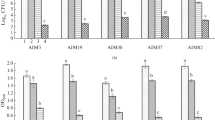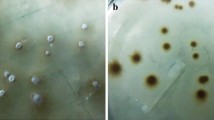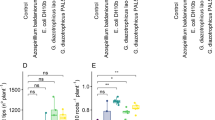Abstract
Indole-3-acetic acid (IAA) is one of the most important molecules produced by Azospirillum sp., given that it affects plant growth and development. Azospirillum brasilense strains Sp245 and Az39 (pFAJ64) were pre-incubated in MMAB medium plus 100 mg/mL l-tryptophan and treated with or exposed to the following (a) abiotic and (b) biotic stress effectors: (a) 100 mM NaCl or Na2SO4, 4.0% (w/v) PEG6000, 0.5 mM H2O2, 0.1 mM abscisic acid, 0.1 mM 1-aminocyclopropane 1-carboxylic acid, 45 °C or daylight, and (b) 4.0% (v/v) filtered supernatant of Pseudomonas savastanoi (Ps) or Fusarium oxysporum (Fo), 0.1 mM salicylic acid (SA), 0.1 mM methyl jasmonic acid (MeJA), and 0.01% (w/v) chitosan (CH). After 30 and 120 min of incubation, biomass production, cell viability, IAA concentration (µg/mL), and ipdC gene expression were measured. Our results show that IAA production increases with daylight or in the presence of PEG6000, ABA, SA, CH, and Fo. On the contrary, exposure to 45 °C or treatment with H2O2, NaCl, Na2SO4, ACC, MeJA, and Ps decrease IAA biosynthesis. In this report, growth and IAA biosynthesis in A. brasilense under biotic and abiotic stress conditions are discussed from the point of view of their role in bacterial lifestyle and their potential application as bioproducts.




Similar content being viewed by others
References
Ahmad P, Rasool S, Gul A, Sheikh SA, Akram NA, Ashraf M, Kazi AM, Gucel S (2016) Jasmonates: multifunctional roles in stress tolerance. Front Plant Sci 7:813
Baldani V, Alvarez M, Baldani J, Döbereiner J (1986) Establishment of inoculated Azospirillum spp. in the rhizosphere and in roots of field grown wheat and sorghum. Plant Soil 90:35–46
Barbieri P, Galli E (1993) Effect on wheat root development of inoculation with an Azospirillum brasilense mutant with altered indole-3-acetic acid production. Res Microbiol 144:69–75
Bashan Y (1998) Inoculants of plant growth-promoting bacteria for use in agriculture. Biotechnol Adv 16(4):729–770
Bashan Y, de-Bashan L (2010) How the plant growth-promoting bacterium Azospirillum promotes plant growth—a critical assessment. Adv Agron 108:77–136
Blaha D, Prigent-Combaret C, Mirza MS, Moënne-Loccoz Y (2006) Phylogeny of the 1-aminocyclopropane-1-carboxylic acid deaminase-encoding gene acdS in phytobeneficial and pathogenic proteobacteria and relation with strain biogeography. FEMS Microbiol Ecol 56:455–470
Bottini R, Fulchieri M, Pearce D, Pharis RP (1989) Identification of gibberellins A1, A3, and iso-A3 in cultures of Azospirillum lipoferum. Plant Physiol 90(1):45–47
Brandl MT, Lindow SE (1996) Cloning and characterization of a locus encoding an indolepyruvate decarboxylase involved in indole-3-acetic acid synthesis in Erwinia herbicola. Appl Environ Microbiol 62:4121–4128
Cesari AB, Paulucci NS, Biasutti MA, Reguera YB, Gallarato LA, Kilmurray C, Dardanelli MS (2016) Reorganization of Azospirillum brasilense cell membrane is mediated by lipid composition adjustment to maintain optimal fluidity during water deficit. J Appl Microbiol 120(1):185–194
Cohen A, Bottini R, Piccoli P (2008) Azospirillum brasilense Sp245 produces ABA in chemically-defined culture medium and increases ABA content in arabidopsis plants. Plant Growth Regul 54(2):97–103
Creus CM, Pereyra MA, Casanovas EM, Sueldo RJ, Barassi CA (2010) Plant growth-promoting effects of rhizobacteria on abiotic stressed plants. Azospirillum-grasses model. AmJPSB 4:49–59
Crozier A, Arruda P, Jasmim JM, Monteiro AM, Sandberg G (1988) Analysis of indole-3-acetic acid and related indoles in culture medium from Azospirillum lipoferum and Azospirillum brasilense. Appl Environ Microbiol 54:2833–2837
Dobbelaere S, Croonenborghs A, Thys A, Vande Broek A, Vanderleyden J (1999) Phytostimulatory effect of Azospirillum brasilense wild type and mutant strains altered in IAA production on wheat. Plant Soil 212:155–164
Horemans S, Koninck K, Neuray J, Hermans R, Vlassak K (1986) Production of plant growth substances by Azospirillum sp. and other rhizosphere bacteria. Symbiosis 2:341–346
Jefferson RA (1987) Assaying chimeric genes in plants: the GUS gene fusion system. Plant Mol Biol Rep 5:387–405
Jensen JB, Egsgaard H, Van Onckelen H, Jochimsen BU (1995) Catabolism of indole-3-acetic acid and 4- and 5-chloroindole-3-acetic acid in Bradyrhizobium japonicum. J Bacteriol 177(20):5762–5766
Kolb W, Martin P (1985) Response of plant roots to inoculation with Azospirillum brasilense and to application of indole acetic acid. In: Klingmüller W (ed) Azospirillum III: genetics, physiology, ecology. Springer, Berlin, pp 215–221
Kloepper J, Lifshitz R, Zablotowicz R (1989) Free-living bacterial inocula for enhancing crop productivity. Trends Biotechnol 7:39–44
Madkour MA, Smith LT, Smith GM (1990) Preferential osmolyte accumulation: a mechanism of osmotic stress adaptation in diazotrophic bacteria. Appl Environ Microbiol 56(9):2876–2881
Miller JH (1972) Experiments in molecular genetics. Cold Spring Harbor Laboratory, Cold Spring Harbor
Molina R, Monzón L, Rivera D, Obando M, Paris G, Cassán F (2014) The effects of light on Azospirillum brasilense Az39. In: Valverde C, Ramirez C, Cassan F (eds) 2do Taller Latinoamericano sobre Rizobacterias Promotoras del Crecimiento de Plantas, pp 77–81
Nabti E, Sahnoune M, Adjrad S, Van Dommelen A, Ghoul M, Schmid M, Hartmann A (2007) A halophilic and osmotolerant Azospirillum brasilense strain from Algerian soil restores wheat growth under saline conditions. Eng Life Sci 7:354–360
Okon Y, Vanderleyden J (1997) Root-associated Azospirillum species can stimulate plants. ASM News 63:366–370
Ona O, Van Impe J, Prinsen E, Vanderleyden J (2005) Growth and indole-3-acetic acid biosynthesis of Azospirillum brasilense Sp245 is environmentally controlled. FEMS Microbiol Lett 246(1):125–132
Patten C, Glick B (1996) Bacterial biosynthesis of indole 3-acetic acid. Can J Microbiol 42:207–220
Perrig D, Boiero ML, Masciarelli OA, Penna C, Ruiz OA, Cassán FD, Luna MV (2007) Plant-growth-promoting compounds produced by two agronomically important strains of Azospirillum brasilense, and implications for inoculant formulation. Appl Microbiol Biotechnol 75(5):1143–1150
Pilet PE, Chollet R (1970) Sur le dosage colorimetrique de l’acide indolylacetique. C R Acad Sci Ser D 271:1675–1678
Prinsen E, Costacurta A, Michiels K, Vanderleyden J, Van Onckelen H (1993) Azospirillum brasilense indole-3-acetic acid biosynthesis: evidence for a non-tryptophan dependent pathway. Mol Plant Microbe Interact 6:609–609
Ray PM (1960) The destruction of indoleacetic acid. III. Relationships between peroxidase and indoleacetic acid oxidation. Arch Biochem Biophys 87:19–30
Reed S, Koren V, Smith M, Zhang Z, Moreda F, Seo DJ, DMIP Participants (2004) Overall distributed model intercomparison project results. J Hydrol 298(1–4):27–60
Spaepen S, Vanderleyden J, Remans R (2007) Indole-3-acetic acid in microbial and microorganism-plant signaling. FEMS Microbiol Rev 31:425–448
Spaepen S, Dobbelaere S, Croonenborghs A, Vanderleyden J (2008) Effects of Azospirillum brasilense indole-3-acetic acid production on inoculated wheat plants. Plant Soil 312:15–23
Strzelczyk E, Kampert M, Li CY (1994) Cytokinin-like substances and ethylene production by Azospirillum in media with different carbon sources. Microbiol Res 149(1):55–60
Tien TM, Gaskinsa MH, Hubbell DH (1979) Plant growth substances produced by Azospirillum brasilense and their effect on the growth of pearl millet (Pennisetum americanum L.). Appl Environ Microbiol 37:1016–1024
Tripathi AK, Nagarajan T, Verma SC, Le Rudulier D (2002) Inhibition of biosynthesis and activity of nitrogenases in Azospirillum brasilense Sp7 under salinity stress. Curr Microbiol 44(5):363–367
Vande Broek A, Lambrecht M, Eggermont K, Vanderleyden J (1999) Auxins upregulate expression of the indole-3-pyruvate decarboxylase gene in Azospirillum brasilense. J Bacteriol 181:1338–1342
Vanstockem M, Michiels K, Vanderleyden J, Van Gool AP (1987) Transposon mutagenesis of Azospirillum brasilense and Azospirillum lipoferum: physical analysis of Tn5 and Tn5-Mob insertion mutants. Appl Environ Microbiol 53:410–415
Acknowledgements
We thank Universidad Nacional de Río Cuarto, Consejo Nacional de Investigaciones Científicas y Tecnológicas (CONICET), Fondo Nacional de Ciencia y Tecnología (FONCyT), and Instituto Nacional de Tecnología Agropecuaria (INTA, Argentina). Fabricio Cassán, Veronica Mora, and Susana Rosas are researchers of CONICET at the UNRC. Romina Molina and Diego Rivera are PhD students at the UNRC with grants from CONICET.
Author information
Authors and Affiliations
Corresponding author
Electronic supplementary material
Below is the link to the electronic supplementary material.
Rights and permissions
About this article
Cite this article
Molina, R., Rivera, D., Mora, V. et al. Regulation of IAA Biosynthesis in Azospirillum brasilense Under Environmental Stress Conditions. Curr Microbiol 75, 1408–1418 (2018). https://doi.org/10.1007/s00284-018-1537-6
Received:
Accepted:
Published:
Issue Date:
DOI: https://doi.org/10.1007/s00284-018-1537-6




